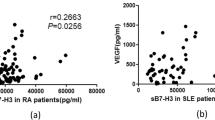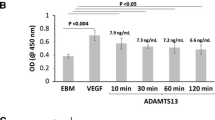Abstract
The transmembrane tyrosine kinase TIE-2, the receptor for the angiopoietins-1 and -2, has been shown to be involved in angiogenic processes. Investigating the regulation of TIE-2 expression on endothelial cells, we found that stimulators such as PMA induce a decrease of TIE-2 protein from the cell surface without affecting TIE-2 mRNA. In conditioned media of PMA stimulated endothelial cells, a soluble form of this receptor comprising parts of the extracellular domain can be detected. Using a sandwich ELISA, we were able to detect and quantify TIE-2 receptors in cell lysates (representing the whole transmembrane receptor) and in cell culture supernatants (representing a soluble form of this receptor, sTIE-2). Several factors influencing this shedding process e.g. basic FGF could be identified. Finally, the soluble form of TIE-2 could also be detected in human biological fluids such as sera and plasma from healthy controls.
Similar content being viewed by others
References
Plate KH, Breier G, Weich HA, Risau W. Vascular endothelial growth factor is a potential tumour angiogenesis factor in human gliomas in vivo. Nature 1992; 359: 845–8.
Aiello LP, Avery RL, Arrigg PG et al. Vascular endothelial growth factor in ocular fluid of patients with diabetic retinopathy and other retinal disorders. N Engl J Med 1994; 331: 1480–7.
Detmar M, Brown LF, Claffey KP et al. Overexpression of vascular permeability factor/vascular endothelial growth factor and its receptors in psoriasis. J Exp Med 1994; 180: 1141–6.
Fava RA, Olson NJ, Spencer-Green G et al. Vascular permeability factor/endothelial growth factor (VPF/VEGF): Accumulation and expression in human synovial fluids and rheumatoid synovial tissue. J Exp Med 1994; 180: 341–6.
Folkman J, D'Amore PA. Blood vessel formation: What is its molecular basis? Cell 1996; 87: 1153–5.
Hanahan D, Folkman J. Patterns and emerging mechanisms of the angiogenic switch during tumorigenesis. Cell 1996; 86: 353–64.
Neufeld G, Cohen T, Gengrinovitch S, Poltorak Z. Vascular endothelial growth factor (VEGF) and its receptors. FASEB J 1999; 13: 9–22.
Veikkola T, Alitalo K. VEGFs, receptors and angiogenesis. Semin Cancer Biol 1999; 9: 211–20.
Dumont DJ, Gradwohl GJ, Fong GH et al. The endothelial-specific receptor tyrosine kinase, tek, is a member of a new subfamily of receptors. Oncogene 1993; 8: 1293–301.
Iwama A, Hamaguchi I, Hashiyama M et al. Molecular cloning and characterization of mouse tie and tek receptor tyrosine kinase genes and their expression in hematopoietic stem cells. Biochem Biophys Res Commun 1993; 195: 301–9.
Valenzuela DM, Griffiths JA, Rojas J et al. Angiopoietins 3 and 4: Diverging gene counterparts in mice and humans. Proc Natl Acad Sci USA 1999; 96: 1904–9.
Koblizek TI, Runting AS, Stacker SA et al. Tie2 receptor expression and phosphorylation in cultured cells and mouse tissues. Eur J Biochem 1997; 244: 774–9.
Hanahan D. Signaling vascular morphogenesis and maintenance. Science 1997; 277: 48–50.
Maisonpierre PC, Suri C, Jones PF et al. Angiopoietin-2, a natural antagonist for Tie2 that disrupts in vivo angiogenesis. Science 1997; 277: 55–60.
Sato TN, Qin Y, Kozak CA, Audus KL. Tie-1 and tie-2 define another class of putative receptor tyrosine kinase genes expressed in early embryonic vascular system. Proc Natl Acad Sci USA 1993; 90: 9355–8.
Dumont DJ, Fong G-H, Puri MC et al. Vascularization of the mouse embryo: A study of flk-1, tek, tie, and vascular endothelial growth factor expression during development. Dev Dyn 1995; 203: 80–92.
Yano M, Iwama A, Nishio H et al. Expression and function of murine receptor tyrosine kinases, Tie and TEK, in hematopoietic stem cells. Blood 1997; 89: 4317–26.
Dumont DJ, Gradwohl G, Fong GH et al. Dominant-negative and targeted null mutations in the endothelial receptor tyrosine kinase, tek, reveal a critical role in vasculogenesis of the embryo. Gen Dev 1994; 8: 1897–909.
Sato TN, Tozawa Y, Deutsch U et al. Distinct roles of the receptor tyrosine kinases Tie-1 and Tie-2 in blood vessel formation. Nature 1995; 376: 70–4.
McCarthy MJ, Burrows R, Bell SC et al. Potential roles of metalloprotease mediated ectodomain cleavage in signaling by the endothelial receptor tyrosine kinase Tie-1. Lab Invest 1999; 79: 889–95.
Yabkowitz R, Meyer S, Black T et al. Inflammatory cytokines and vascular endothelial growth factor stimulate the release of soluble tie receptor from human endothelial cells via metalloprotease activation. Blood 1999; 93: 1969–79.
Siemeister G, Schirner M, Weindel K et al. Two independent mechanisms essential for tumor angiogenesis: Inhibition of human melanoma xenograft growth by interfering with either the vascular endothelial growth factor receptor pathway or the Tie-2 pathway. Cancer Res 1999; 59: 3185–91.
Barleon B, Totzke F, Herzog C et al. Mapping of the sites for ligand binding and receptor dimerization at the extracellular domain of the VEGF receptor FLT-1. J Biol Chem 1997; 272: 10382–8.
Rose-John S, Heinrich PC. Soluble receptors for cytokines and growth factors: Generation and biological function. Biochem J 1994; 300: 281–90.
Heaney ML, Golde DW. Soluble cytokine receptors. Blood 1996; 87: 847–57.
Kendall RL, Thomas KA. Inhibition of vascular endothelial cell growth factor activity by an endogenously encoded soluble receptor. Proc Natl Acad Sci USA 1993; 90: 10705–9.
Yabkowitz R, Meyer S, Yanagihara D et al. Regulation of tie receptor expression on human endothelial cells by protein kinase C-mediated release of soluble tie. Blood 1997; 90: 706–15.
Partanen J, Armstrong E, Makela TP et al. A novel endothelial cell surface receptor tyrosine kinase with extracellular epidermal growth factor homology domains. Mol Cell Biol 1992; 12: 1698–707.
Kendall RL, Wang G, Thomas KA. Identification of a natural soluble form of the vascular endothelial growth factor receptor, FLT-1, and its heterodimerization with KDR. Biochem Biophys Res Commun 1996; 226: 324–8.
Hornig C, Behn T, Bartsch W et al. Detection and quantification of complexed and free soluble human vascular endothelial growth factor receptor-1 (sVEGFR-1) by ELISA. J Immunol Meth 1999; 226: 169–77.
Hornig C, Barleon B, Ahmad S et al. Release and complex formation of soluble VEGFR-1 from endothelial cells and biological fluids. Lab Invest 2000; 80: 443–54.
Barleon B, Reusch P, Totzke F et al. Soluble VEGFR-1 secreted by endothelial cells and monocytes is present in human serum and plasma from healthy donors. Angiogenesis 2001; 4: 143–154 (this issue).
Marron MB, Hughes DP, Edge MD et al. Evidence for heterotypic interaction between the receptor tyrosine kinase TIE-1 and TIE-2. J Biol Chem 2000; 275: 39741–6.
Kremer C, Breier G, Risau W, Plate KH. Up-regulation of flk-1/vascular endothelial growth factor receptor 2 by its ligand in a cerebral slice culture system. Cancer Res 1997; 57: 3852–9.
Pepper MS, Mandriota SJ. Regulation of vascular endothelial growth factor receptor-2 (Flk-1) expression in vascular endothelial cells. Exp Cell Res 1998; 241: 414–25.
Lin P, Buxton JA, Acheson A et al. Antiangiogenic gene therapy targeting the endothelium-specific receptor tyrosine kinase Tie2. Proc Natl Acad Sci USA 1998; 95: 8829–34.
Baron AT, Lafky JM, Boardman CH et al. Serum sErbB1 and epidermal growth factor levels as tumor biomarkers in women with stage III or IV epithelial ovarian cancer. Cancer Epidemiol Biomarkers Prev 1999; 8: 129–37.
Stephens RW, Nielsen HJ, Christensen IJ et al. Plasma urokinase receptor levels in patients with colorectal cancer: Relationship to prognosis. J Natl Cancer Inst 1999; 19: 869–74.
McCabe NP, Angwafo FF, Zaher A et al. Expression of soluble urokinase plasminogen activator receptor may be related to outcome in prostate cancer patients. Oncol Rep 2000; 7: 879–82.
Adams J, Carder PJ, Downey S et al. Vascular endothelial growth factor (VEGF) in breast cancer: Comparison of plasma, serum, and tissue VEGF and microvessel density and effects of tamoxifen. Cancer Res 2000; 1: 2898–905.
Takeda A, Shimada H, Imaseki H et al. Clinical significance of serum vascular endothelial growth factor in colorectal cancer patients: Correlation with clinicopathological factors and tumor markers. Oncol Rep 2000; 7: 333–8.
Harris AL, Reusch P, Barleon B et al. Soluble Tie2 and Fltl extracellular domains in serum of patients with renal cancer and response to antiangiogenic therapy. Clinical Cancer Res 2001; 7: 1992–7.
Author information
Authors and Affiliations
Rights and permissions
About this article
Cite this article
Reusch, P., Barleon, B., Weindel, K. et al. Identification of a soluble form of the angiopoietin receptor TIE-2 released from endothelial cells and present in human blood. Angiogenesis 4, 123–131 (2001). https://doi.org/10.1023/A:1012226627813
Issue Date:
DOI: https://doi.org/10.1023/A:1012226627813




